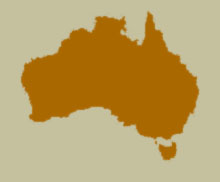Synonyms
Serangium bellum Slipinski and Burckhardt, 2006: 40.
Diagnosis
The abundant dorsal pubescence, large elytral spots and lateral grooves on the 5th abdominal ventrite distinguish S. bellum from the other Australian Serangium species.
Description
Length 1.9-2.5 mm. Brown or black dorsally, brown or black ventrally, abdominal sternites reddish brown; elytra with a conspicuous yellow or ochreous dot in middle; tibiae and tarsi dirty yellowish. Winged; body shape hemispherical; pronotal margins laterally and posteriorly with very narrow rim, visible from above; elytra with conspicuous swelling near humeral edge; elytral margins with narrow rim, entirely visible from above. Head, pronotal and elytral surface shiny; head densely, coarsely punctate except for the middle, punctures separated by about twice their diameter, covered in long sparse hairs. Pronotum densely covered in fine punctures associated with long setae, punctures separated by about 3 times their diameter. Scutellum elongate, triangular, flat, shiny, glabrous. Elytra with punctures slightly sparser than on pronotum, entirely covered in long sparse setae. Head with moderately large eyes, separated by 2.0 times eye width; flattened medially. Clypeus flat, long, straight anteriorly. Terminal maxillary palpomere moderately broad, oval, obliquely truncate apically, terminal labial palpomere narrow and aciculate. Antenna 9-segmented, scape weakly expanded apically, club elongate, inner margin convex, apex angular. Prosternum mat, surface weakly furrowed, sparsely setose; mesosternum mat, impunctate; metasternum shiny, with each a group of coarse punctures on the lateral anterior corner and scattered punctures anteriorly, bearing a few irregularly spaced setae. Elytral epipleuron brown or black, broad, flat or weakly excavate and perpendicular to elytron in anterior half, with punctures and some long setae, narrowing to a mere rim in apical half. Anterior margin of profemur strongly angled in apical third. Tarsus 4-segmented. Abdomen with ventrite 1 large, shiny, with a few scattered punctures and associated setae; ventrites 2-5 small, mostly mat, densely punctured and setose. Last ventrite grooved laterally.
Male
Male genitalia as figured.
Female
UNDER CONSTRUCTION
Variation
UNDER CONSTRUCTION
 Distribution and Biology
Distribution and Biology
UNDER CONSTRUCTION
Species References
Slipinski, A. and Burckhardt, D. 2006. Revision of the Australian Coccinellidae (Coccinellidae). Part 5. Tribe Serangiini. Annales Zoologici (Warszawa), 56(1): 37-58.
[ Top ]
